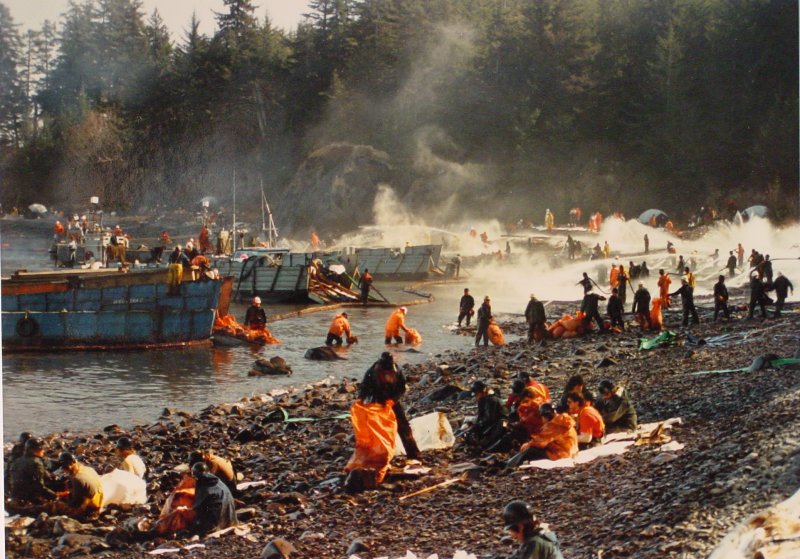
Crews spray dispersant at Big Smith Island, following the 1989 Exxon Valdez oil spill. Researchers now have the genetic tools to determine the impact of this work on the long-term sustainability of some animal populations. (Flickr photo/Jim Brickett)
No one doubts that an oil spill is a serious environmental crisis. Besides being a mess, it’s often immediately deadly to birds, fish, and mammals. This body count — as grim as it sounds — is an important tool for researchers to measure the impact of the spill.
But how do we account for the creatures affected by oil spills which don’t immediately die? Recently, a team from the Mote Marine Laboratory was in Sitka to study this very problem.
In the lab…
The basement of the Sitka Sound Science Center is packed to the gills with fish. A pair of huge tanks with several hundred young coho salmon, known as smolt, sit in the middle of the room. Lining the walls are another 25 tanks or so, where the coho were exposed to various amounts of crude oil.

Drs. Dana Wentzel (l.) and John Reynolds with test tanks in the basement of the Sitka Sound Science Center. The pair chose coho salmon for their study because they represent a typical “nearshore species” likely to show effects from even light dilutions of oil or dispersant in seawater. (KCAW photo/Robert Woolsey)
“What we do is take samples, and we go back to the lab and work on that for months and months. So we’ve taken tissue samples from liver and kidney, the spleen and gill. We’re also taking blood samples, and we’re analyzing those to see what sorts of changes can we see to their immune system. That’s kind of a big deal.”
Dr. Dana Wentzel is a chemist who works at the Mote Marine Laboratory in Sarasota, Florida. She designed this experiment, hoping to learn what happens to the fish that don’t die right away in an oil spill. Since the Exxon Valdez spill in 1989, there have been huge advancements in our understanding of genetics. Scientists may have wondered what impact the 11-million gallons of crude had on the health of animals that survived the spill itself, but they didn’t have the tools to find the answers.
“New technology is created all the time, fortunately. And things that we couldn’t do before, or we couldn’t do with very good resolution, we can now. So expertise improves, instrumentation improves, new approaches are determined. And things like looking at the fish immune system — things that weren’t sought after the Exxon Valdez spill — but now we can do these things. Now we’re hoping to make some sense of predictions during a spill event, and what that might mean for managers and resource directors, commercial fishing, recreational fishing, and subsistence.”
So Wentzel has mixed up a cocktail of oil — and the substance we apply to clean it up, called a dispersant — pumped it into the small tanks around the room, and added a few fish. Now she’ll wait to see what happens. She’ll crunch the data she’s already collected, and return to Sitka in four months to gather more.
The oil, by the way, is the real thing.
KCAW – What kind of oil were you putting in the tanks?
Wentzel – North Slope crude oil.
KCAW – Really? You just called up Conoco and asked for a barrel?
Wentzel – Not quite a barrel. But we had some resources that we were able to got the oil from.
KCAW – What about the dispersant? What’s commonly used nowadays?
Wentzel – Commonly, it’s Corexit 9500. That’s what was used on Deepwater Horizon spill.
Deepwater Horizon sent nearly 5-million barrels of oil into the Gulf of Mexico in 2010. Dr. John Reynolds was there.
“A year after Deepwater Horizon, the dolphins up in Barataria Bay (Louisiana), the main focal point of the spill coming onshore — those animals looked horrible. They had skin lesions, they were skinny, there weren’t a lot of calves. But they were still swimming around. They hadn’t been killed. It wasn’t lethal. Clearly those animals had been debilitated in some ways.”
Reynolds is the biologist on this team. He’s trying to understand the sublethal impact of oil and dispersants. There’s a spectrum of problems a spill can create for organisms — none of which kill right away.
“A lot of times after an oil spill we count how many animals are out there alive. And if they’re alive, we assume that they’re all healthy and reproducing and just doing grand. And we count how many wash up on shore, whether it’s fish or marine mammals or birds. But the fact of the matter is that if reproduction is impaired for years, that’s going to affect the sustainability of stocks. If their immune system is impaired, then the next major stressor may do in a lot of fish, or marine mammals, or whatever. It’s important that if you’re going to model the long-term sustainability of stocks that have been impacted by a spill — or any stressor, for that matter — it’s important to not just understand mortality, but also reproduction and immune competence of those species.”
Both Reynolds and Wentzel hope their work can be applied in the field, to help crisis managers respond to not just what is happening, but what may happen. Scientists have long suspected there’s more damage happening in spills than meets the eye. This study — though small — could be critical in understanding what’s actually at risk in a spill.
“Depending on the outcome of this, what you may see is a more conservative approach to oil and gas development, a more aggressive approach to cleanup. Because if we find that there are some of these sublethal effects that can jeopardize sustainability, the goal is to minimize the likelihood of that.”































